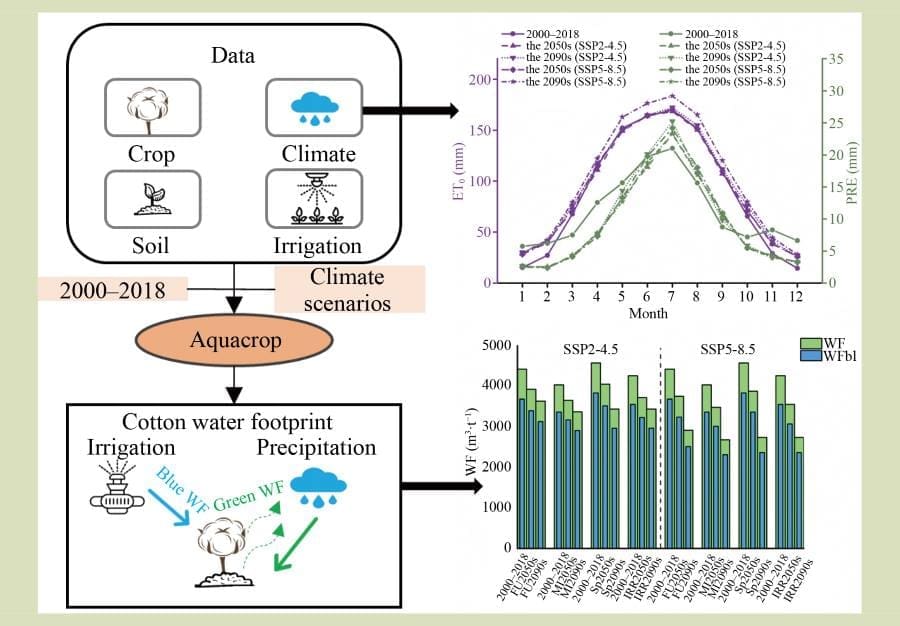Explore the latest insights from top science journals in the Muser Press daily roundup (June 24, 2025), featuring impactful research on climate change challenges.
In brief:
Climate change impacts sexual and reproductive health of refugee youth in Ugandan humanitarian setting
Extreme weather events driven by climate change have profound consequences for the sexual and reproductive health of young refugees in Uganda, according to a new study published in Global Public Health. The study reveals that extreme weather events worsen resource insecurities and increase sexual and reproductive health risks for youth in Uganda’s Bidi Bidi Refugee Settlement, one of the world’s largest humanitarian settings.
“The study powerfully illustrates the interconnectedness of climate stress and youth sexual and reproductive health in humanitarian settings,” says lead author Dr. Carmen Logie, Professor at the University of Toronto’s Factor-Inwentash Faculty of Social Work (FIFSW) and Canada Research Chair in Global Health Equity and Social Justice with Marginalized Populations, as well as Adjunct Professor at the United Nations University Institute for Water, Environment and Health (UNU-INWEH). “Refugee settlements are facing not just environmental hazards, but cascading threats to young people’s health, safety, and future.”

The study’s authors include researchers at the University of Toronto who worked in collaboration with the Uganda Refugee and Disaster Management Council (URDMC), a community-based organization that protects the rights of refugees, asylum seekers and internally displaced persons in Uganda. Youth aged 16 to 24 living in Bidi Bidi Refugee Settlement were engaged in walk-along interviews, which involved walking with research staff to a place where they access food, water and sanitation resources for the interview to be conducted. Interviews were also conducted with service providers working closely with the youth.
“These youth shared that resource scarcity is an issue within the Bidi Bidi refugee settlement,” says co-author Frannie MacKenzie, Research Officer at FIFSW. “Extreme weather events intensify these vulnerabilities and expose youth to unprecedented sexual and reproductive health risks that have profound impacts on their lives.”
The study found that drought and flooding-related resource insecurities increased refugee youth’s exposure to sexual and gender-based violence and engagement with transactional sex. During droughts, youth often travel long distances at night to collect water, increasing their risk of violence. Droughts and floods reduce crop yields and food rations, pushing youth into early marriage and transactional sex to access food. These climate related pressures are placing refugee youth, particularly young women, at a heightened risk of unplanned pregnancy, HIV and STIs, and menstruation management challenges.
The study’s researchers call for urgent integration of climate-informed strategies to address sexual and reproductive health at community, interpersonal, and socio-political levels, with specific attention to the gendered impacts of resource insecurity.
“Integrating climate-resilient sexual and reproductive health interventions is essential,” says co-author Simon Odong Lukone, Field Coordinator at URDMC. As co-applicant and co-author Dr. Moses Okumu, Assistant Professor at the University of Illinois Urbana-Champaign explained: “There is an urgent need for humanitarian systems and programs to address sexual and reproductive health needs in the face of climate stressors”
Journal Reference:
Logie, C. H., Loutet, M., MacKenzie, F., Okumu, M., Leggett, R., Akinwande, F. S., … Narasimhan, M., ‘Experiences of drought, heavy rains, and flooding and linkages with refugee youth sexual and reproductive health in a humanitarian setting in Uganda: qualitative insights’, Global Public Health 20, 1, (2025). DOI: 10.1080/17441692.2025.2503863
Article Source:
Press Release/Material by University of Toronto
Climate change and depopulation confirmed as the main concerns affecting mountain areas in Europe
In Europe, mountain areas account for about 36% of the total territory and are home to 16% of the population, but they are crucial for the continent as a whole. The availability of basic commodities, like water,depends on them, they play a key role in carbon sequestration, and are areas of biodiversity.
And, as if that were not enough, the value chains of different consumer products, especially foodstuffs, are developed in these mountain systems. Therefore, they are complex and valuable socio-ecological systems that are threatened by diverse factors divergingfrom those affecting other areas.
To shed light on these specificities and devise adaptation strategies to address them, a team at the University of Cordoba turned to those who know these mountain areas best: the local actors who live and work in them.

As part of the MOVING project, coordinated by the University of Cordoba, the team analyzed the vulnerability of 23 mountainous areas in 16 European countries using a participatory methodology that engages the communities in each area related to the value chains of their most representative products.
“In each territory, a multi-stakeholder platform was created in which the agricultural and livestock sector, research center staff, political representatives, companies, associations and institutions were invited to participate,” explained María del Mar Delgado, a professor in the Department of Agricultural Economics, Finance and Accounting, who is heading up the project.
Through surveys, workshops and interviews with more than 500 local agents, the team managed to learn about their perceptions of the vulnerabilities of each area and the impact of these stresses and threats on the final product.
The results of this work, pioneering at the European level due to the scope of the territory analyzed, indicate that, although the elements that affect these spaces vary according to the characteristics of each one, changes in climate and demography are having the greatest impact on mountain areas.
As explained by researcher Pablo González, with the Department of Forestry Engineering at the UCO, “aspects such as the lack of rainfall, or extreme weather events, as well as the depopulation of rural areas and changes in land use, are significantly affecting the value chains of products from mountain areas.” The study shows that the mountain areas of Turkey and Bulgaria, Sierra Morena, and certain mountain ranges in Portugal, are detecting the greatest impact.
In the case of Andalucía, the project focused on the Sierra Morena and its value chain of Iberian products, and the Sierras Béticas, with its olive oil proceding mountain olive groves. In both cases, the most important element highlighted by local agents was drought or changes in precipitation patterns. In the case of the Sierra Morena, pests, invasive species and the overexploitation of resources due to excessive livestock were also major concerns. As for mountain olive groves, another of the elements pointed out was population lossin rural areas.
More than 160 adaptation mechanisms
The good news, González explained, is that the impact of these changes can be reduced by incorporating adaptation mechanisms. In the course of the participatory process promoted by the MOVING project, local agents identified more than 160 adaptation mechanisms of different kinds, ranging from the implementation of sustainable agricultural and livestock practices, to commitments to applied research, to the development of effective policies, especially on the part of the European Union.
“When we incorporate this adaptive capacity, the impact is reduced by more than half,” explained González, who pointed out that not all the mechanisms proposed are equally applicable. However, “those that we do consider feasible, some of which are already being applied, could reduce the overall vulnerability of the systems by up to 50%.”
The team responsible for the project states that one of the most pertinent aspects of the participatory process carried out is the opportunity it offers local agents to meet, listen to each other, debate and exchange impressions and knowledge. In addition, the study gathers their perceptions and what they are willing to change, thus enabling communities and value chains to be involved in the design and implementation of strategies to help reduce the vulnerability of mountain areas and, thus, that of Europe as a whole.
Journal Reference:
González-Moreno, P., Schmitt, E., Moreno-Ortiz, J. et al., ‘Assessing the vulnerability of mountain value chains to environmental and social drivers in Europe: A land-use and stakeholder-based approach’, Ambio (2025). DOI: 10.1007/s13280-025-02153-5
Article Source:
Press Release/Material by University of Córdoba (UCO)
How likely are extreme hot weather episodes in today’s UK climate?
In a study published in Weather, researchers estimated the current chances and characteristics of extreme hot episodes in the UK, and how they have changed over the last 6 decades.
The team found that temperatures several degrees above those recorded during the UK’s heatwave in July 2022 are plausible in today’s climate, with a simulated maximum of over 45°C (113°F). The likelihood of 40°C (104°F) is now over 20 times more likely than it was in the 1960s. Moreover, the chance of 40°C will likely continue to rise as the climate warms. The investigators estimate that there is approximately a 50% chance of again exceeding 40°C in the next 12 years.
Through multiple storylines of how temperatures could evolve through the summer season, they also found that prolonged heatwaves of over a month above 28°C (82°F) are possible in southeast England today. These storylines are valuable for modeling and stress testing.
“Our findings highlight the need to prepare and plan for the impacts of rising temperatures now, so we can better protect public health, infrastructure, and the environment from the growing threat of extreme heat,” said corresponding author Gillian Kay, PhD, of the Met Office Hadley Centre.
Journal Reference:
Kay, G., Dunstone, N., Smith, D.M., Brown, S.J., Kent, C., Lockwood, J.F. and Scaife, A.A., ‘Rapidly increasing chance of record UK summer temperatures’, Weather (2025). DOI: 10.1002/wea.7741
Article Source:
Press Release/Material by Wiley
Bulking up for solar power
As we witness the detrimental effects of climate change, the need for a rapid shift to renewable energy is only becoming more urgent. One of the most efficient forms of renewable energy, solar power, is generated by solar cells, which are the building blocks of solar panels. These electronic devices use semiconductors to convert the energy of light into electricity, a process called the photovoltaic effect.
Conventional solar cells have fundamental limitations in output voltage and conversion efficiency. A phenomenon called the bulk photovoltaic effect, which has attracted much attention in recent years, may enable highly efficient solar energy conversion without such limitations. However, the essential physics of the bulk photovoltaic effect have not been fully understood.

This effect originates from quantum phenomena and involves the asymmetric photoexcitation behavior of electrons, causing a steady electrical charge flow called a shift current, which is usually generated in the system with space-inversion symmetry. Another current materializes when there is a break in time-reversal symmetry, or the symmetry of physical laws when the flow of time is reversed.
Since time-reversal symmetry is broken in magnetic materials, new effects related to the bulk photovoltaic effect are expected to arise in magnetic systems, but many aspects of these systems remain unexplained both theoretically and experimentally.
This motivated a team of researchers at Kyoto University to observe these new phenomena, requiring them to overcome technical difficulties in controlling spatial and time-reversal symmetry. The team created a new artificial heterostructure device with a monolayer two-dimensional semiconductor and a magnetic layered material meant to mimic broken spatial and time-reversal symmetry at its hetero-interface.
With their device, the team measured current-voltage characteristics under light illumination by changing the temperature and spin direction, for which they applied an external magnetic field. The results indicated that the team’s device shows new bulk photovoltaic effect of the magnetic-injection current, which is an extremely promising material platform for next-generation photovoltaic devices.
“Our study has shown that spatial and time-reversal symmetry can be flexibly controlled by artificial structures, enabling a variety of optical responses and current generation that have not been seen before,” says corresponding author Kazunari Matsuda.
In particular, the team demonstrated that the magnetic injection current can be controlled by an external magnetic field, which is expected to lead to new applications not only in solar cells but also in technologies like optical sensors, spintronics, and energy harvesting devices.
Furthermore, this research indicates that the shift current and the magnetic injection current can coexist, making it possible to develop photovoltaic systems that are more efficient and multifunctional than ever before.
“Our research shows there is great potential in magnetic systems for the development of next generation solar-cells,” says Matsuda.
Journal Reference:
Asada, S., Shinokita, K., Watanabe, K. et al., ‘Nonlinear photovoltaic effects in monolayer semiconductor and layered magnetic material hetero-interface with P- and T-symmetry broken system’, Nature Communications 16, 4827 (2025). DOI: 10.1038/s41467-025-58918-9
Article Source:
Press Release/Material by Kyoto University (KyotoU)
How will the ‘water footprint’ of Xinjiang cotton change under climate change?
According to the Sixth Assessment Report by the Intergovernmental Panel on Climate Change (IPCC), human activities have significantly intensified global warming, leading to more frequent, intense, and prolonged extreme weather events, which pose a major threat to agricultural production.
Xinjiang, as one of the driest regions in China, has an average annual precipitation of less than 270 mm and an evaporation rate exceeding 1000 mm, yet it produces 25% of the world’s cotton, contributing 91.0% of the national cotton production and 35% of farmers’ income. Cotton cultivation in this region heavily relies on irrigation, and climate change is likely to exacerbate aridity in Xinjiang. In this context, how will the water use structure of cotton production in Xinjiang change? How can the water-saving potential of different irrigation technologies be assessed?
A study conducted by Dr. La Zhuo and colleagues from the Institute of Soil and Water Conservation at Northwest A&F University, published in Frontiers of Agricultural Science and Engineering, provides the answers to these questions.

This study focuses on the “water footprint” of cotton production in Xinjiang — specifically, the amount of freshwater consumed to produce one ton of cotton, divided into “blue water footprint” (relying on groundwater or surface water) and “green water footprint” (relying on precipitation).
Unlike previous studies that primarily focused on food crops or single irrigation methods, this research innovatively simulates three mainstream irrigation technologies, furrow irrigation, micro-irrigation (drip irrigation), and sprinkler irrigation, at a fine grid scale of 5 arcminutes (approximately 9 km × 9 km), analyzing the spatiotemporal changes in cotton’s water footprint under two climate change scenarios for the 2050s and 2090s (SSP2-4.5 moderate emissions and SSP5-8.5 high emissions).
The study first reveals the future climate trends in Xinjiang: compared to the baseline period of 2000–2018 (with a reference crop evapotranspiration ET0 of 1080 mm), evaporation demand in Xinjiang significantly increases under both scenarios. In the SSP5-8.5 scenario of the 2090s, ET0 increases by 14.3% annually, with the largest increases occurring in January and November, while the summer increase is only about 8%. Annual precipitation decreases by 15.1% overall, with only July to September slightly exceeding the baseline period. This indicates that Xinjiang will become increasingly arid in the future, and the pressure on agricultural water use may further intensify.
However, a key finding is that the total water footprint of cotton shows a downward trend. The total water footprint for cotton in Xinjiang during the baseline period is 4264 m3·t-1, of which blue water accounts for 83% (3560 m3·t-1). By the 2090s, the total water footprint is expected to decrease by 19.3% under the SSP2-4.5 scenario, and by 35.7% under the SSP5-8.5 high emissions scenario. This is mainly attributed to the effects of increased atmospheric CO2 concentration — under the SSP5-8.5 scenario, CO2 concentration is significantly higher than under SSP2-4.5, and higher CO2 levels can enhance the photosynthetic efficiency of cotton while reducing transpiration water loss.
It is noteworthy that the structure of the water footprint is changing: the proportion of blue water in the total water footprint is expected to increase slightly. Although the total amount of blue water is also decreasing—by 16.5% and 33.4% under the SSP2-4.5 and SSP5-8.5 scenarios, respectively — the contribution of green water declines due to reduced precipitation, leading to an increased proportion of blue water. The decline in green water footprint is more pronounced, decreasing by 33.7% and 47.2% under the SSP2-4.5 and SSP5-8.5 scenarios, with only a few areas experiencing slight increases due to minor precipitation increases.
There are significant differences in the water-saving potential of the three irrigation technologies: sprinkler irrigation shows a reduction in water footprint of 24.8% and 40.1% under the SSP2-4.5 and SSP5-8.5 scenarios, respectively, demonstrating the most notable water-saving effects; furrow and micro-irrigation show relatively smaller reductions. This indicates that sprinkler irrigation technology has higher water-saving potential for future cotton cultivation in Xinjiang.
The cotton industry in Xinjiang is crucial for the regional economy, but water resource scarcity is a long-term challenge. This study not only quantifies the dynamic patterns of cotton water consumption under climate change but also clarifies the adaptive differences among various irrigation technologies, providing scientific support for optimizing water resource allocation and promoting water-saving measures. In the future, combined with variety improvement and agronomic upgrades, Xinjiang cotton is expected to achieve more efficient water resource utilization in an increasingly arid environment.
Journal Reference:
Pengcheng TIAN, Zhiwei YUE, Xiangxiang JI, Ning YAO, Pute WU, La ZHUO, ‘Water footprint of irrigated cotton production in Xinjiang under predicted climate change scenarios’, Frontiers of Agricultural Science and Engineering 12 (2): 367‒377 (2025). DOI: 10.15302/J-FASE-2024585
Article Source:
Press Release/Material by Higher Education Press
Featured image credit: Gerd Altmann | Pixabay




